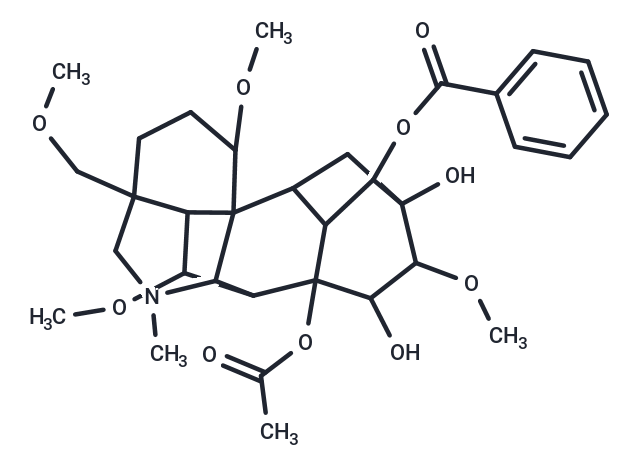Shopping Cart
- Remove All
 Your shopping cart is currently empty
Your shopping cart is currently empty

Hypaconitine, an active and highly toxic constituent derived from Aconitum species, possesses anti-inflammatory activity and is widely used to treat rheumatism.

| Pack Size | Price | Availability | Quantity |
|---|---|---|---|
| 1 mg | $36 | In Stock | |
| 5 mg | $83 | In Stock | |
| 10 mg | $133 | In Stock | |
| 25 mg | $249 | In Stock | |
| 50 mg | $397 | In Stock | |
| 100 mg | $592 | In Stock | |
| 500 mg | $1,250 | In Stock | |
| 1 mL x 10 mM (in DMSO) | $113 | In Stock |
| Description | Hypaconitine, an active and highly toxic constituent derived from Aconitum species, possesses anti-inflammatory activity and is widely used to treat rheumatism. |
| In vitro | Hypaconitine (0.08-2 microM) depressed the nerve-evoked twitch tension, without affecting the contraction evoked by stimulation of the muscle,At the concentrations of hypaconitine (up to 5 microM)that depressed the nerve-evoked twitch tension, the resting membrane potential of the muscle cells was unchanged. Hypaconitine (0.1-2 microM) blocked the end-plate potential (epp), without affecting the amplitude of the miniature epp (mepp). The quantal content of end-plate potentials was decreased by these agents in parallel with the decrement in amplitude. |
| Animal Research | Adult Wistar rats were orally administered?Hypaconitine?(0.23, 0.69, 2.07 mg/kg per day), liquiritin (20 mg/kg per day), or?Hypaconitine?(2.07 mg/kg per day) plus liquiritin (20 mg/kg per day) for seven consecutive days. The mRNA expression levels of CaM and Cx43 in rat myocardial tissue were determined by real-time quantitative PCR. The protein contents of CaM and phosphorylated Cx43 (Ser368) were determined by Western blot |
| Molecular Weight | 615.71 |
| Formula | C33H45NO10 |
| Cas No. | 6900-87-4 |
| Smiles | COCC12CCC(OC)C34C5CC6(O)C(OC(=O)c7ccccc7)C5C(OC(C)=O)(C(C(OC)C13)C4N(C)C2)C(O)C6OC |
| Relative Density. | 1.35g/cm3 |
| Storage | Powder: -20°C for 3 years | In solvent: -80°C for 1 year | Shipping with blue ice. | ||||||||||||||||||||||||||||||
| Solubility Information | DMSO: 50 mg/mL (81.21 mM), Sonication is recommended. | ||||||||||||||||||||||||||||||
Solution Preparation Table | |||||||||||||||||||||||||||||||
DMSO
| |||||||||||||||||||||||||||||||

Copyright © 2015-2025 TargetMol Chemicals Inc. All Rights Reserved.